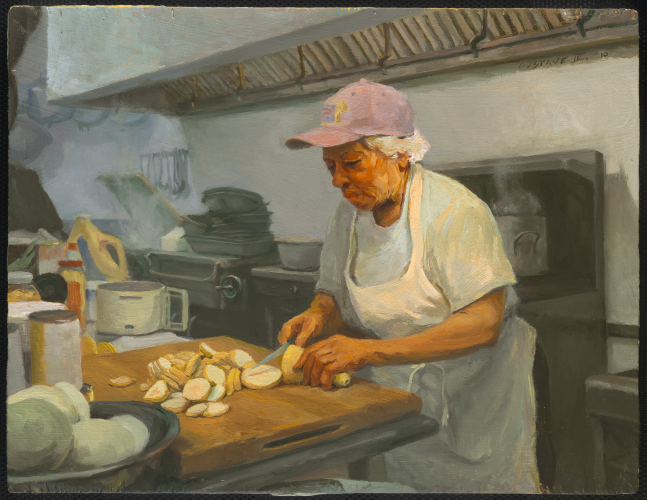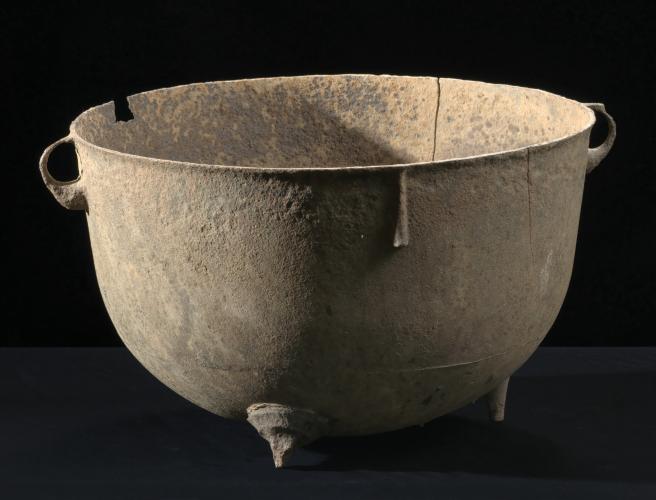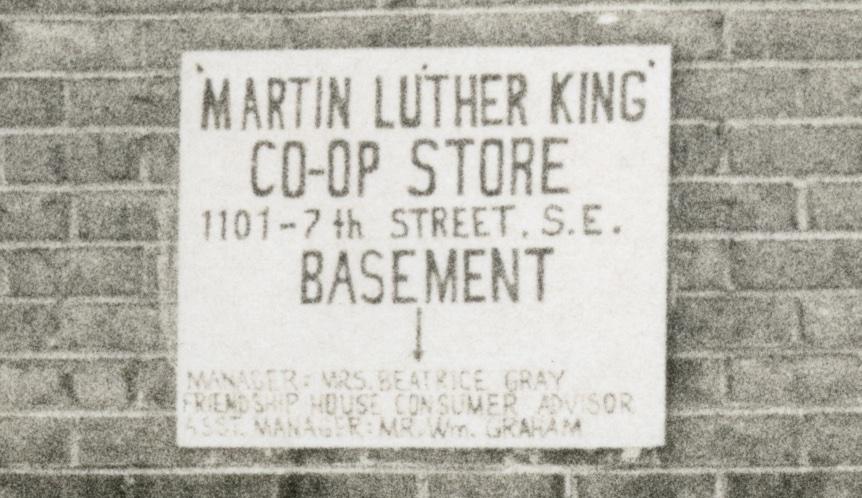
“Cutting Squash (Leah Chase)” by Gustave Blache III, 2010. Oil on panel. National Portrait Gallery, Smithsonian Institution; gift of the artist in honor of Mr. Richard C. Colton, Jr. © Gustave Blache III
By Hannah S. Ostroff of the Smithsonian, Amy Stamm of the National Air and Space Museum, Karen Vidangos of the National Portrait Gallery, and the social media team at the National Museum of African American History and Culture
Black women have influenced American food history in countless ways. Several Smithsonian museums and Smithsonian Secretary Lonnie G. Bunch III recently shared stories of Black Food History on social media. They highlighted women who nourished families and communities. Here are their stories.
1. TV Chef and Cookbook Author Lena Richard

Filming Lena Richard (center) at WDSU-TV studio. Courtesy of Newcomb Archives and Vorhoff Library, Tulane University.
More than a decade before Julia Child, cookbook author Lena Richard had her own TV cooking show. On "Lena Richard's New Orleans Cookbook," likely the first TV program in the country that starred an African American chef, she guided viewers through her recipes.
Richard built a culinary empire in New Orleans during the Jim Crow era. She owned and operated catering businesses, eateries, a fine-dining restaurant, a cooking school specifically for Black students, and a frozen food business.
In 1939, she became the first African American author of a published cookbook on Creole cuisine. White cookbook authors writing about Creole cuisine had often downplayed or ignored the role of Black culinary professionals. Richard's cookbook broke down harmful stereotypes by emphasizing the labor, time, and training that went into her work. As a published author, she to claimed Creole recipes for herself and her African American community.
Learn more about Richard from the Smithsonian's National Museum of American History and in the Sidedoor podcast episode, "Lena Richard: America's Unknown Celebrity Chef."
2. Stouffer's Employees
During the first few Apollo Moon landing missions, the astronauts were kept in isolation, first in the Mobile Quarantine Unit and then in the Lunar Receiving Lab, for three weeks to make sure they didn't bring any "Moon germs" back with them. (They didn't.) One challenge NASA faced was making sure they had food for the astronauts that could be easily made in the Lunar Receiving Lab. NASA employees needed to feel 100% confident the food was free of any harmful bacteria. After all, if the astronauts got sick, they didn't want to have to wonder if it was from the food or from the hypothetical "Moon germs."
NASA turned to Stouffers for the solution: microwavable meals that could be easily heated up and had been tested thoroughly by Stouffers. Sara Thompson, a quality control supervisor, was one of the people who ensured the food maintained the level of purity that NASA required. Her contributions to the Apollo program were highlighted in an article in the Black newspaper the New York Amsterdam News.
The National Air and Space Museum shared Thompson's contributions on their Twitter account. They recommend learning more through the online magazine Lady Science.
3. Restauranteur Leah Chase

“Cutting Squash (Leah Chase)” by Gustave Blache III, 2010. Oil on panel. National Portrait Gallery, Smithsonian Institution; gift of the artist in honor of Mr. Richard C. Colton, Jr. © Gustave Blache III
"In my dining room, we changed the course of America over a bowl of gumbo and some fried chicken." —Leah Chase
Born in 1923 in Madisonville, Louisiana, chef Leah Chase was dubbed the Queen of Creole Cuisine. She brought New Orleans Creole cooking to international attention through cookbooks, TV appearances, and a restaurant.
With her husband, jazz musician Edgar "Dooky" Chase II, she converted a New Orleans sandwich shop into a fine-dining establishment. Dooky Chase's Restaurant became a gathering spot for Martin Luther King Jr. and other prominent civil rights activists who held strategy sessions there in the 1960s.
Later in her life, Leah Chase advocated for the arts, collecting works by African American artists. She became the first African American board member of the New Orleans Museum of Art.
See Leah Chase's chef's jacket and other objects from Dooky Chase's Restaurant in the National Museum of African American History and Culture.
4. Mother and Daughter Amanda Caldwell and Susan Caldwell McGill

“Cutting Squash (Leah Chase)” by Gustave Blache III, 2010. Oil on panel. National Portrait Gallery, Smithsonian Institution; gift of the artist in honor of Mr. Richard C. Colton, Jr. © Gustave Blache III
This iron pot from the National Museum of African American History and Culture belonged to Manda (Amanda) Caldwell and her daughter Susie (Susan) Caldwell McGill. Manda Caldwell was born enslaved in the 19th century in York County or Cherokee County areas of South Carolina.
Iron pots such as this were used by enslaved women for many utilitarian purposes, including washing clothes, making lye soap, and cooking large quantities of food outside, such as cornmeal or rice seasoned with a bit of pork fat. Some families would also have had access to fish, game, or vegetables from their own garden plots.
Creative cooking methods helped nourish enslaved families in body and soul. Inadequate food supplied by enslavers provided only two-thirds of the calories necessary to sustain a hard-working adult. Often working in the dark, after a long day in the fields, African Americans hunted, fished, and grew vegetables and medicinal herbs to keep themselves strong.
Learn more in the National Museum of African American History & Culture's Cultural Expressions exhibition.
5. Nutritionist Beatrice Gray

Photo of Martin Luther King Co-Op Store sign. Anacostia Community Museum.
Noticing her neighbors in Southeast Washington, D.C., lacked access to quality grocery stores, nutritionist Beatrice Gray organized buying clubs where people could access affordable food in the 1960s. She later opened the nation's first cooperative grocery store inside of a public housing community. The co-op was located inside the Arthur Capper public housing project on Capitol Hill.
Operating for more than a decade, Gray's co-op was one way residents of D.C.'s predominantly Black neighborhoods tried to combat food deserts—areas where people have little access to a variety of fresh food. Residents also led protests, spoke to store owners about improving quality, circulated petitions, and researched store conditions in different neighborhoods, making the case for higher quality, fairer prices, and better treatment in neighborhoods that that had predominantly African American residents.
Learn more about Gray's work and D.C.'s food system by visiting the exhibition Food for the People: Eating and Activism in Greater Washington at the Smithsonian's Anacostia Community Museum.
Related Posts
Hannah S. Ostroff is a digital communications editor at the Smithsonian. She manages the institution's central social media accounts, sharing the depth and breadth of the Smithsonian with audiences on Instagram, Twitter, and Facebook.
Amy Stamm is the head of social and editorial content at the Smithsonian's National Air and Space Museum. She works across various digital platforms to share iconic moments in aviation and space and elevate lesser-known stories and voices.
Karen Vidangos is the social media specialist for the National Portrait Gallery and formerly the social media strategist for Our Shared Future: Reckoning with Our Racial Past. Her work explores the people who have shaped the nation's history, development, and culture through portraiture.
The social media team at the National Museum of African American History and Culture includes Cara Bernard, Atiya Dorsey, Ksenia Grishkova Orol, and Sarah Stio.